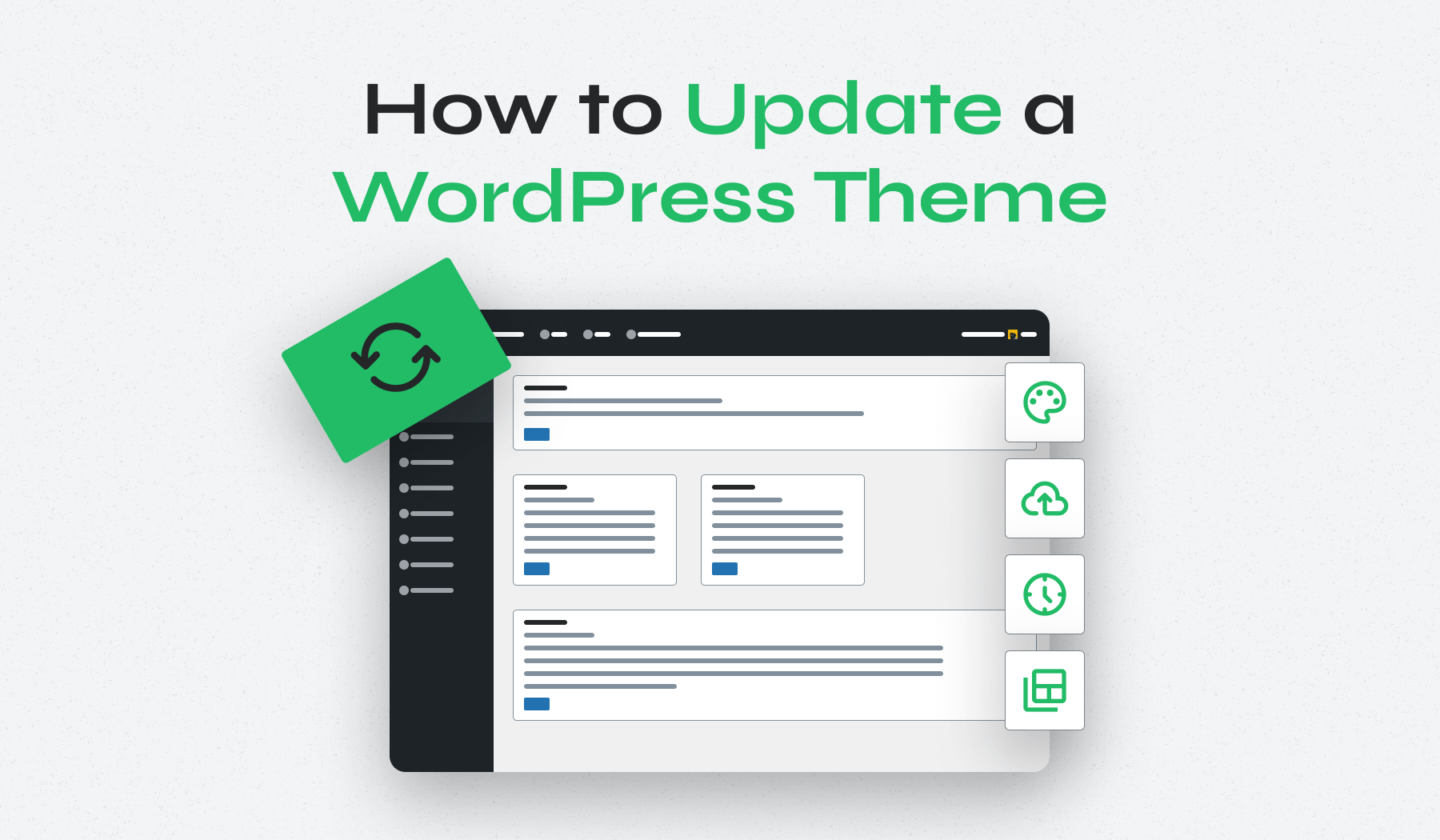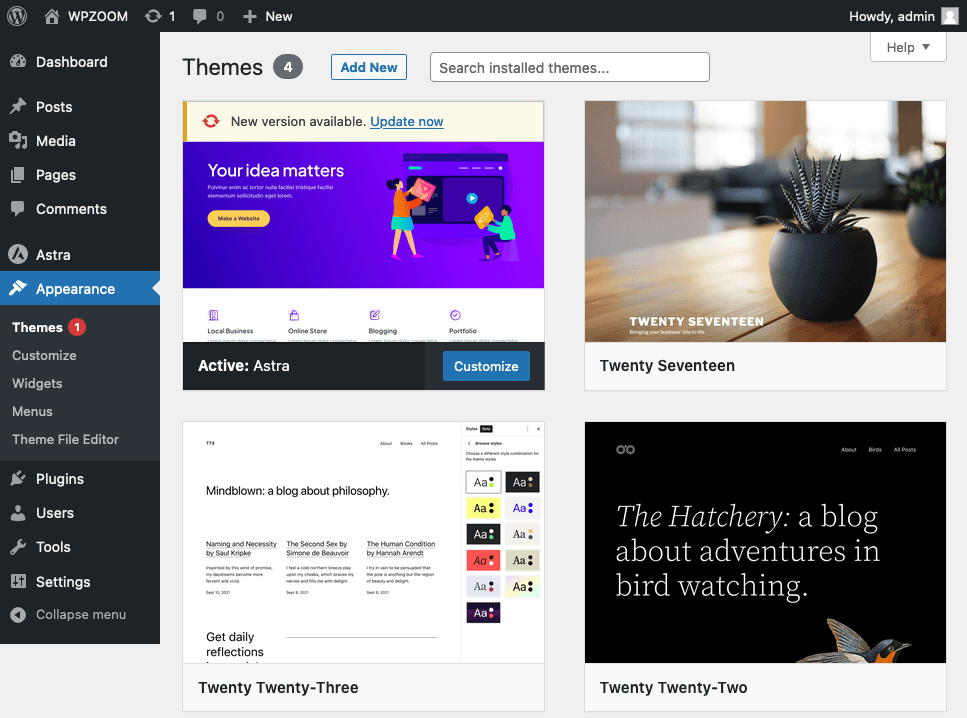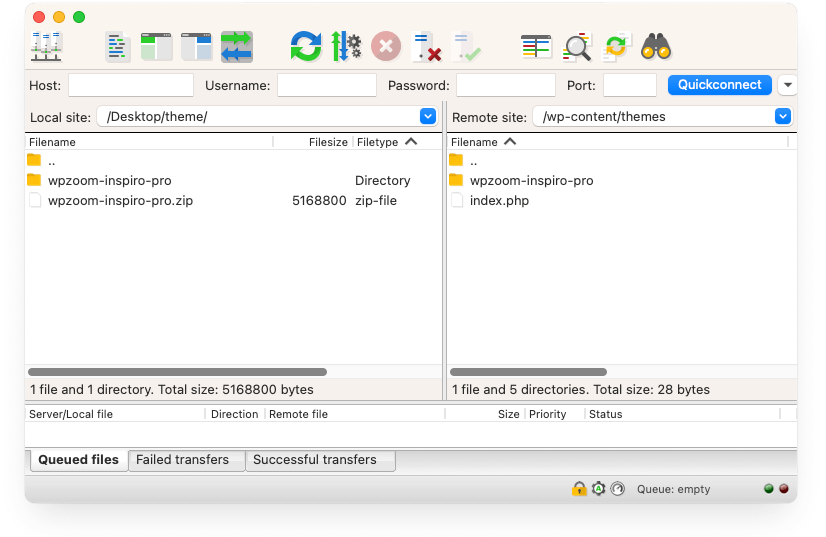
Updating your WordPress theme is crucial for keeping your site secure, functional, and visually appealing. However, it can be a daunting task, especially when you’ve customized your theme.
In this comprehensive guide, we’ll walk you through how to update a WordPress theme without losing any of your customizations. You’ll learn essential preparatory steps, various methods for updating your theme, and tips for safeguarding your custom design and functionality.
Table of Contents
- Essential Pre-Update Checklist
- How to Update a WordPress Theme: 3 Effective Methods
- The Benefits of Updating Your WordPress Theme
Essential Pre-Update Checklist
Before diving into the update process, it’s crucial to take a few preparatory steps to ensure everything goes smoothly. This pre-update checklist will help you safeguard your customizations, minimize downtime, and prevent data loss.
1. Preserve Your Theme Customizations
When updating your WordPress theme, it’s essential to protect your customizations to prevent them from being overwritten. Here are detailed steps and best practices to ensure your custom design and functionality remain intact during the update process:
- Understand Your Customizations. First, identify all the customizations you’ve made to your theme. This includes changes to the theme’s code, custom CSS, and any additional functionality added through functions.php. Knowing what you’ve customized will help you take the necessary steps to preserve these changes.
- Use a Child Theme. The best way to protect your customizations is by using a child theme. A child theme inherits the functionality and styling of the parent theme but allows you to make modifications without altering the parent theme’s files. This means that when you update the parent theme, your customizations remain intact. Here’s how to set up a child theme.
- Document Your Changes. Keep a detailed record of all the changes you make to your theme. This documentation will be invaluable if you need to reapply customizations after an update. Include notes on which files were modified and the specific changes made.
- Custom CSS in the Customizer. If you have added custom CSS through the WordPress Customizer (Appearance > Customize > Additional CSS), these changes are stored in the database and not in the theme files. They should remain unaffected by theme updates. However, it’s still a good practice to copy this custom CSS to a safe location as a backup.
- Leverage Plugins for Custom Functionality. For added functionality, consider using plugins instead of adding code directly to your theme’s files. Plugins are independent of your theme and won’t be affected by theme updates. Custom functionality added through plugins can easily be maintained and updated separately.
- Check for Theme-Specific Update Instructions. Some custom themes come with specific update instructions provided by the developer. Check the theme’s documentation or the developer’s website for any guidelines on how to safely update the theme without losing customizations.
By following these steps, you can ensure that your theme customizations are preserved during updates, maintaining the unique look and functionality of your website.
2. Back Up Your Website
Backing up your website protects you from data loss, theme conflicts, plugin issues, and potential security breaches. It’s a safety net that allows you to revert to a fully functional version of your site if something goes wrong during the update.
There are several methods to back up your WordPress website, each with its own advantages. Choose the one that best fits your needs:
- Manual Backup via cPanel. If you prefer a hands-on approach, you can manually back up your website using cPanel
- Using a Backup Plugin. There are numerous WordPress backup plugins available that can automate the backup process. Popular options include UpdraftPlus, Duplicator, and WP STAGING. These plugins often allow you to schedule regular backups, store backups in various locations, and easily restore from a backup if needed.
- Hosting Provider’s Backup Service. Many hosting providers offer built-in backup services. Check with your hosting provider to see if they provide automated backups and how you can access and restore these backups.
After creating your backup, verify that the files and database have been successfully saved and are accessible. Open the backup files to ensure they contain your website data.
This preparation minimizes the risk of data loss and makes it easier to recover your site if any issues arise during the update process.
3. Test Updates on a Staging Site
Before applying updates directly to your live site, it’s essential to test them in a staging environment. A staging site allows you to replicate your live website in a controlled environment where you can safely make changes without affecting your users. Here’s how to effectively test updates on a staging site:
- Set Up a Staging Site. Many hosting providers offer easy-to-use staging environments as part of their service. If your host provides this feature, follow their instructions to set up a staging site. If not, you can use plugins like WP STAGING or Duplicator to create a staging environment manually.
- Clone Your Live Site. Ensure that your staging site is an exact replica of your live website. This includes all content, themes, plugins, and settings. The more accurate the clone, the more reliable your testing will be. Most staging tools offer a one-click cloning process to make this easy.
- Perform the Update on the Staging Site. Once your staging site is set up, proceed with updating the theme as you would on your live site. This involves following the same steps and methods (automatic, manual, FTP, or cPanel) you plan to use for the live update.
- Thoroughly Test Your Site. After updating the theme on your staging site, perform comprehensive tests to ensure everything functions correctly.
By testing updates on a staging site, you can prevent disruptions, ensure a smooth transition, and maintain the integrity of your live website.
4. Choose the Optimal Timing for Updates
Timing your updates can significantly affect your website’s availability. Schedule updates during low-traffic periods to minimize the impact on visitors.
Analyze your website’s traffic patterns to identify periods of low activity. Use tools like Google Analytics to determine when your site experiences the least amount of traffic. Typically, late nights or early mornings are quieter times for most websites. Scheduling updates during these periods can reduce the impact on your visitors.
Ensure that you or your technical team is available to monitor the update process and handle any issues that might arise immediately afterward. Updating your theme when you can be present ensures that any problems can be swiftly addressed, minimizing downtime.
If your website has a significant user base, consider announcing scheduled maintenance. This can be done through a banner on your site, email notifications, or social media posts. Informing your visitors in advance about the maintenance window sets expectations and helps maintain trust.
How to Update a WordPress Theme: 3 Effective Methods
Updating your WordPress theme can be done through various methods, depending on your preferences and technical expertise. Whether you prefer using the WordPress dashboard, FTP, or cPanel, this guide covers each method in detail to ensure a seamless update process.
Follow the steps below to update your WordPress theme safely and efficiently.
Method 1: Update Your WordPress Theme Through the WordPress Dashboard
The WordPress dashboard provides a user-friendly interface to update your theme directly. Here’s how to do it:
- Log in to your WordPress dashboard. Navigate to Appearance > Themes to view your installed themes.
- In the Themes section, you’ll see a notification if an update is available for your theme. Click on the theme thumbnail to open its details.
- If an update is available, you will see an Update Now button. Click this button to start the update process. WordPress will automatically download and install the latest version of the theme.

Also, you can update themes by going to Dashboard > Updates. Select all the themes you want to update and click on Update Themes.

Optional: If you prefer to automate the process, you can enable automatic updates. Within the theme details window, look for the Enable auto-updates button and click it.

This will ensure that future updates are applied automatically. However, it’s important to note that this is suitable for standard themes without customizations, as automatic updates could overwrite any custom changes. Not all themes support Auto Updates and some may require manual intervention.
Method 2: Update Your WordPress Theme Manually via FTP
If your theme does not support the dashboard method or you prefer more control over the update process, you can update it manually using FTP:
- Obtain the latest version of your theme from the theme developer’s website or the WordPress theme repository. Unzip the downloaded file on your computer.
- Use an FTP client like FileZilla to connect to your website. Enter your FTP credentials to access your site’s file directory.
- In the FTP client, go to the /wp-content/themes/ directory where your current theme files are located.
- Drag and drop the new theme folder to the themes directory. If prompted, choose to overwrite the existing files. This replaces the old theme files with the updated ones.

After the transfer is complete, log into your WordPress dashboard to confirm the theme update was successful.
Make sure you don’t delete the old theme before uploading the new one to avoid any downtime.
Method 3: Update a WordPress Theme Using cPanel
Updating your theme using cPanel is another effective method, especially if you encounter issues with the WordPress dashboard or FTP:
- Obtain the latest version of your theme from the developer’s website or the WordPress theme repository. Save the file to your computer and unzip it.
- Access your cPanel account through your hosting provider.
- In cPanel, navigate to the File Manager, typically found under the Files section.
- Within the File Manager, go to /public_html/wp-content/themes/.
- Upload the zipped theme file to the themes directory. Once uploaded, select the file and click Extract to unzip it. Overwrite the old theme files with the new ones.
The Benefits of Updating Your WordPress Theme
Regularly updating your WordPress theme is vital for maintaining the overall health and performance of your website. Here are some key benefits of keeping your theme up-to-date:
- Enhanced Security. Theme updates often include patches for security vulnerabilities discovered since the last version. By updating your theme, you close these loopholes and protect your site from potential threats. Regular updates are a crucial defense against common web attacks, ensuring your website remains secure for your visitors.
- Improved Performance. Updates frequently come with performance enhancements that can make your website faster and more efficient. Optimized code, reduced load times, and better resource management are common improvements in theme updates. These enhancements contribute to a smoother user experience and can positively impact your site’s SEO ranking.
- Access to New Features. Theme developers continuously add new features and improvements to keep their themes competitive and functional. By updating your theme, you gain access to the latest customization options, new widgets, and improved functionalities that can enhance your site’s design and user experience.
- Compatibility with WordPress Core Updates. WordPress regularly releases updates to its core software, which can sometimes change how themes and plugins interact with it. Updating your theme ensures that it remains compatible with the latest WordPress version, preventing functionality issues or site breakdowns. This compatibility is crucial for the smooth operation of your site and all its components.
Regularly updating your WordPress theme is a straightforward task that brings numerous benefits. It enhances your site’s security, performance, and user experience while ensuring compatibility with the latest WordPress core updates. By following the tips and strategies outlined in this article, you can make theme updates a hassle-free process, keeping your site in top shape with each new version.




